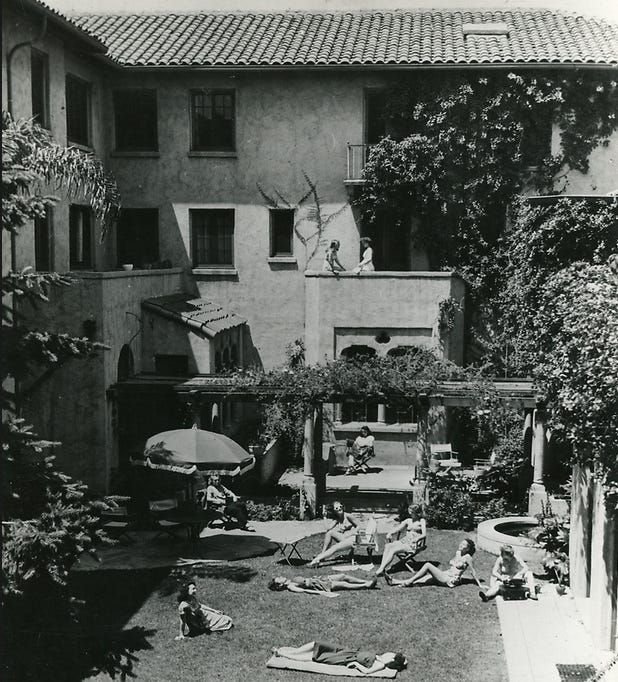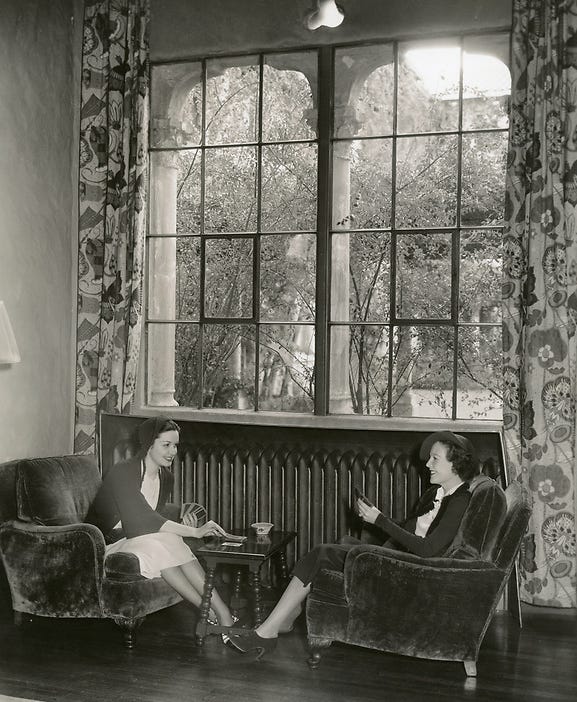Sanctuary for Early Hollywood Actresses
The Hollywood Studio Club was a sorority-type place in Los Angeles where young women could thrive while waiting to make it big.
When I was researching a presentation for a large company on she sheds and women’s quest for repose and control, I stumbled across the Hollywood Studio Club. For nearly 50 years, this fascinating place gave “sanctuary” to more than 10,000 women when they needed it most. Stars like Marilyn Monroe, Sharon Tate, Kim Novak, Rita Moreno, and Donna Reed were residents between the late 40s and the 60s.
I was reminded of my brief stay at the Allerton Hotel for Women in the 80s when I first moved to NYC after graduating college. Dreary as it was, my room was safe and cheap. I was grateful. (New York City was also the birthplace of The Rehearsal Club in 1913, a “boarding house for theatrical ingenues,” likely an inspiration to the founders of the Club on the West Coast a few years later.)
(The Hollywood Studio Club when it expanded to a larger building in 1926. Photo: hollywoodphotographs.com)
Desperate to “Make it Big”
In early Hollywood (1920s - 1950s), women often hung around studios and worked odd jobs in the area in hopes of lucking out and being discovered. Their eagerness to become a movie star (and their impoverished circumstances) made these inexperienced teenagers and 20-somethings easy targets for the unscrupulous in the business. Predatory directors, photographers, screenwriters, casting directors and the douchebags who pretended to be decision makers were a constant threat.
The Hollywood Studio Club had a large living room with a piano and a stage where residents could rehearse or just let off steam. (Photo: hollywoodphotographs.com)
The Hollywood Studio Club was originally launched in 1916 by Eleanor Jones, the head librarian of the Hollywood Public Library. She noticed young women gathering at the library tables to read plays and swap advice. She realized many of them were living in seedy boarding houses and hotels. Jones met with the YWCA to see if they were interested in helping her find a house to convert into a small women’s dorm. They were successful and were aided with contributions from Mary Pickford, Constance Adams DeMille, and others in the film industry. The original Studio Club was a lovely columned mansion on Carlos Ave., long gone now.
About ten years later after a large fundraising campaign, the Studio Club moved into a Mediterranean-style building designed by Julia Morgan. It was spacious and light-filled with an inner courtyard where women could relax and soak up the sun.
(Photo: hollywoodphotographs.com)
Rules were strict: No men were allowed past the first floor, where a large living room filled with couches, upholstered chairs, a piano, and lots of ashtrays were available for date pickups and casual gatherings.
(Photo: hollywoodphotographs.com)
The YWCA’s decision to create this place just for women trying to break into show business was a truly prescient and powerful thing. Barbara Eden, who got her big break starring in the TV series “I Dream of Jeannie” after scrounging her way through bit parts, said that if it wasn’t for the Studio Club she would not have made it in show business. Sally Struthers was only allowed to go to Hollywood because of the Club’s association with the YWCA — “my mother trusted the YWCA.” She went on to star in “All in the Family” and many other TV and movie roles, and is still working 50+ years later.
Residents of the Hollywood Studio Club had access to a dining hall that served two meals a day, acting classes, practice rooms, and sewing machines. Dances and teas were also part of the schedule. (Photo: hollywoodphotos.com)
HSC’s Second Act
By the 70s, women’s residences fell out of favor and the Studio Club struggled to fill its rooms. In 1975, it closed for good. Fortunately, the Morgan-designed building was put on the National Register of Historic Places and was protected from demolition.
Guess what it is now? In 2018, the YWCA partnered with PATH (People Assisting the Homeless) and re-opened the Hollywood Studio Club as a 60-room temporary housing residence for women experiencing homelessness.
The Search for Repose and Control
Looking at the photos of these women, taken more than 80 years ago, you see carefully posed faces and bright smiles. What you don’t see is how positively terrifying that leap must have been. Of the many thousands who took the Greyhound to Hollywood and lived at the Studio Club, probably 90% or more of them returned back home.
I wonder if they looked back fondly on the experience, or ever came back to peek into the Club where they once dreamed of being a movie star. I hope that whatever city or suburb or farmhouse they ended up in they were able to recreate a little bit of space where they could pursue their dreams.
A Hollywood ending is not the only happy ending.







Julia Morgan designed lots of women's residences (in my area, the Oakland YWCA and what is now the San Francisco Zen Center, originally a residence for young Jewish women). Someone asked her why she was going to such trouble for "just girls." She replied that was exactly the point—single girls needed comfortable, elegant places to live, exercise, and think. She changed a lot of lives by providing spaces for women.
Your storytelling skills shine in this, Erika.